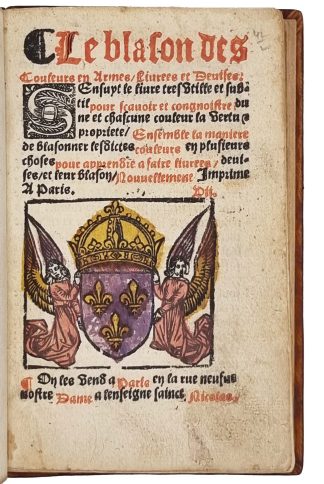SICILE, Jean Courtois.
CONTEMPORARY COLOURING
Le blason des couleurs en armes livrees et devises. S᾽ensuyt le livre ... pour scavoir et congnoistre dune et chascune couleur la vertu et propriété
Paris, en la rue neufve Nostre Dame à l’enseigne saint Nicolas [Jean Saint-Denis ou Pierre Sergent ?], [n.d. c. 1528]£7,500.00
8vo. ff. (iv) 53 (i.e. 52). A-O4. Lettre Bâtard. Title printed in red and black, lovely woodcut printer’s device of angels holding the arms of France, repeated on B2 recto, both with contemporary hand colouring, 48 woodcut banners and roundels in text, also in contemporary hand colouring, charming white on black floriated criblé initials in various sizes. Light age yellowing, t-p and a few leaves of text slightly thumbed in lower outer corner. A very good copy, crisp and clean, in C19th reverse calf.
Extremely rare and beautifully printed early edition of this famous heraldic text by Sicile, one of the earliest treatises on heraldry in French, with additional material probably by Gilles Corrozet whose acrostic ‘Carroset’ is found in the last paragraph, beautifully illustrated with contemporary hand colouring. The text is divided into two parts, the first on the emblazoning of arms, or the use of colour in heraldry, in which Sicile describes the conditions that must be met for entrance to knighthood (including an emotional plea that the traditional dubbing ceremony be reinstituted.). The second part details the appropriateness of the colouring of different articles of clothing for men and women and the meaning of these colours. “The date of the composition of the first part probably lies between 1435-58; that of the second part about 1530. The first portion of Part II … has been copied and adapted from Corbichon’s translation of Galnville.. The woodcut of the Arms of France on the title is repeated on A6 (here B2): that and the 48 labels and roundels on other pages being coloured by stencilling as originally issued and marked. On D1 (here G1) is the ‘Blason sur les sept aage de l’homme’. In the second part “Des inventions des couleurs: Habit moral de l’homme selon les couleurs’ enumerating the different articles of clothing of men and women, with appropriateness of their colours. … the author makes an interesting reference to distinguished painters: “Les oeuvres de maistre Jehan fouquet: de maistre Jehan de Paris…” Fouquet the famous miniaturist, …died about 1485, Jean Perreal, also known as Jean de Paris, flourished about 1472-1528” Fairfax-Murray.
Jean Courtois, called Sicily Herald, was in the service of Pierre de Luxembourg, the count of Saint-Pol before later joining the service of the king of the two Sicilies, Alfonso V of Aragon, though he lived for a long time in Mons in the Netherlands. His work was most influential and reprinted often in the C16th. Rabelais’ character Gargantua gives a violent tirade against the author of the “Blason des couleurs”, especially for his use of colours to create social distinctions. A fresh copy of this uncommon and important work.
BM STC Fr. C16. p. 401. Fairfax Murray 618 (another near identical edn. by the same printer but in octavo). Brunet VII. 135. USTC No. 22436. Moreau-Renouard, III, 1913. Saffroy, I, 2009. Bechtel, B-216. Pettegree, etc. French Vernacular Books, Books published in the French language before 1601. 47945In stock





